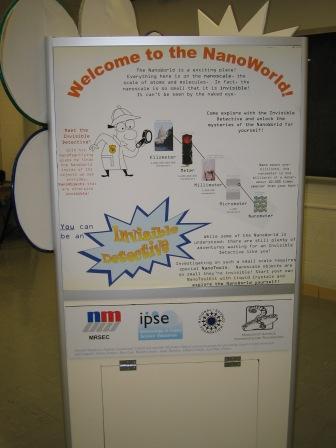

 |
Liquid Crystal Exhibit |
| Nanosensors represent an important application of nanotechnology; their compact size and increased sensitivity are a marked improvement over existing "macro" sensing technologies. Liquid Crystals are an example of a nanomaterial that has been used for sensing applications. This exhibit prototype introduces the visitor to liquid crystals, uses interactives to teach the visitor about how LCs function and demonstrates current applications of liquid crystal technology. | |
 |
This panel of the exhibit introduces the visitor to the concept of the "nano" scale. The Invisible Detective, introduced here, guides the visitor through the mysteries of the invisible nanoworld discussed in the rest of the exhibit. |
 |
This part of the exhibit exposes the visitor to current nanotechnology research with a heat-sensitive liquid crystal sensor that the visitor can control. At the touch of a button, a hair dryer heats the sensor, and the monitor displays the change, as seen under the microscope. In this way, the visitor is able to view, in real time, the liquid crystal sensing heat.(Liquid crystal samples were generously provided by the Nicholas Abbott research group.) The accompanying text teaches the visitor about the mechanism by which liquid crystals sense various stimuli. The visitor can also read about how light and wavelength affect the nanoscale (i.e. why nanoscale objects can't be seen with the naked eye).  |
 |
This panel of the exhibit features applications of liquid crystals. The visitor learns about three different stimuli to which liquid crystals are sensitive (heat, chemicals, and electric fields). The visitor can choose a stimulus and, at the push of a button, the application(s) corresponding to that that stimulus lights up. The visitor can also interact with the exhibit by placing his or her hand on a sheet of liquid crystals and observing the color change from body heat. The bottom panel teaches the visitor basic facts about liquid crystals, including what type of molecules they are made of. |

  |
|